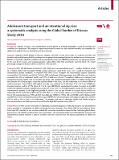Files in this item
Adolescent transport and unintentional injuries : a systematic analysis using the Global Burden of Disease Study 2019
Item metadata
| dc.contributor.author | GBD 2019 Adolescent Transport and Unintentional Injuries Collaborators | |
| dc.contributor.author | Peden, Amy | |
| dc.date.accessioned | 2022-08-15T15:30:07Z | |
| dc.date.available | 2022-08-15T15:30:07Z | |
| dc.date.issued | 2022-08-01 | |
| dc.identifier | 280387159 | |
| dc.identifier | 9eee204b-bee8-4ef9-ba64-beca04d8de5c | |
| dc.identifier | 85134996790 | |
| dc.identifier | 000852189200008 | |
| dc.identifier.citation | GBD 2019 Adolescent Transport and Unintentional Injuries Collaborators & Peden , A 2022 , ' Adolescent transport and unintentional injuries : a systematic analysis using the Global Burden of Disease Study 2019 ' , The Lancet Public Health , vol. 7 , no. 8 , pp. e657-e669 . https://doi.org/10.1016/S2468-2667(22)00134-7 | en |
| dc.identifier.issn | 2468-2667 | |
| dc.identifier.other | RIS: urn:C9CE1664E79160060BEC03C19238A878 | |
| dc.identifier.uri | https://hdl.handle.net/10023/25849 | |
| dc.description | Funding information: This Article was supported by the Bill & Melinda Gates Foundation. | en |
| dc.description.abstract | Background Globally, transport and unintentional injuries persist as leading preventable causes of mortality and morbidity for adolescents. We sought to report comprehensive trends in injury-related mortality and morbidity for adolescents aged 10–24 years during the past three decades. Methods Using the Global Burden of Disease, Injuries, and Risk Factors 2019 Study, we analysed mortality and disability-adjusted life-years (DALYs) attributed to transport and unintentional injuries for adolescents in 204 countries. Burden is reported in absolute numbers and age-standardised rates per 100 000 population by sex, age group (10–14, 15–19, and 20–24 years), and sociodemographic index (SDI) with 95% uncertainty intervals (UIs). We report percentage changes in deaths and DALYs between 1990 and 2019. Findings In 2019, 369 061 deaths (of which 214 337 [58%] were transport related) and 31·1 million DALYs (of which 16·2 million [52%] were transport related) among adolescents aged 10–24 years were caused by transport and unintentional injuries combined. If compared with other causes, transport and unintentional injuries combined accounted for 25% of deaths and 14% of DALYs in 2019, and showed little improvement from 1990 when such injuries accounted for 26% of adolescent deaths and 17% of adolescent DALYs. Throughout adolescence, transport and unintentional injury fatality rates increased by age group. The unintentional injury burden was higher among males than females for all injury types, except for injuries related to fire, heat, and hot substances, or to adverse effects of medical treatment. From 1990 to 2019, global mortality rates declined by 34·4% (from 17·5 to 11·5 per 100 000) for transport injuries, and by 47·7% (from 15·9 to 8·3 per 100 000) for unintentional injuries. However, in low-SDI nations the absolute number of deaths increased (by 80·5% to 42 774 for transport injuries and by 39·4% to 31 961 for unintentional injuries). In the high-SDI quintile in 2010–19, the rate per 100 000 of transport injury DALYs was reduced by 16·7%, from 838 in 2010 to 699 in 2019. This was a substantially slower pace of reduction compared with the 48·5% reduction between 1990 and 2010, from 1626 per 100 000 in 1990 to 838 per 100 000 in 2010. Between 2010 and 2019, the rate of unintentional injury DALYs per 100 000 also remained largely unchanged in high-SDI countries (555 in 2010 vs 554 in 2019; 0·2% reduction). The number and rate of adolescent deaths and DALYs owing to environmental heat and cold exposure increased for the high-SDI quintile during 2010–19. Interpretation As other causes of mortality are addressed, inadequate progress in reducing transport and unintentional injury mortality as a proportion of adolescent deaths becomes apparent. The relative shift in the burden of injury from high-SDI countries to low and low–middle-SDI countries necessitates focused action, including global donor, government, and industry investment in injury prevention. The persisting burden of DALYs related to transport and unintentional injuries indicates a need to prioritise innovative measures for the primary prevention of adolescent injury. Funding Bill & Melinda Gates Foundation. | |
| dc.format.extent | 13 | |
| dc.format.extent | 2444008 | |
| dc.language.iso | eng | |
| dc.relation.ispartof | The Lancet Public Health | en |
| dc.subject | RA0421 Public health. Hygiene. Preventive Medicine | en |
| dc.subject | RJ101 Child Health. Child health services | en |
| dc.subject | 3rd-DAS | en |
| dc.subject | SDG 3 - Good Health and Well-being | en |
| dc.subject | MCC | en |
| dc.subject.lcc | RA0421 | en |
| dc.subject.lcc | RJ101 | en |
| dc.title | Adolescent transport and unintentional injuries : a systematic analysis using the Global Burden of Disease Study 2019 | en |
| dc.type | Journal article | en |
| dc.contributor.institution | University of St Andrews. School of Medicine | en |
| dc.contributor.institution | University of St Andrews. Population and Behavioural Science Division | en |
| dc.identifier.doi | https://doi.org/10.1016/S2468-2667(22)00134-7 | |
| dc.description.status | Peer reviewed | en |
This item appears in the following Collection(s)
Items in the St Andrews Research Repository are protected by copyright, with all rights reserved, unless otherwise indicated.

